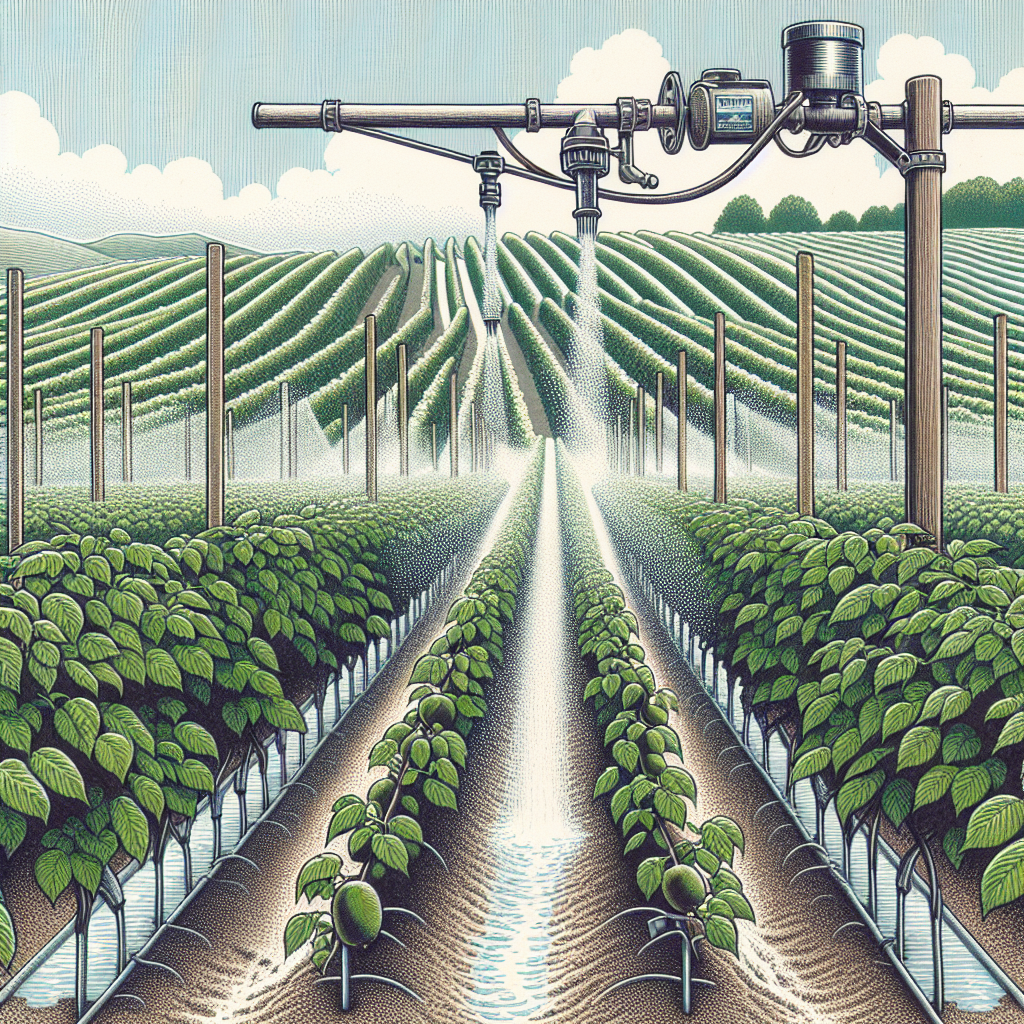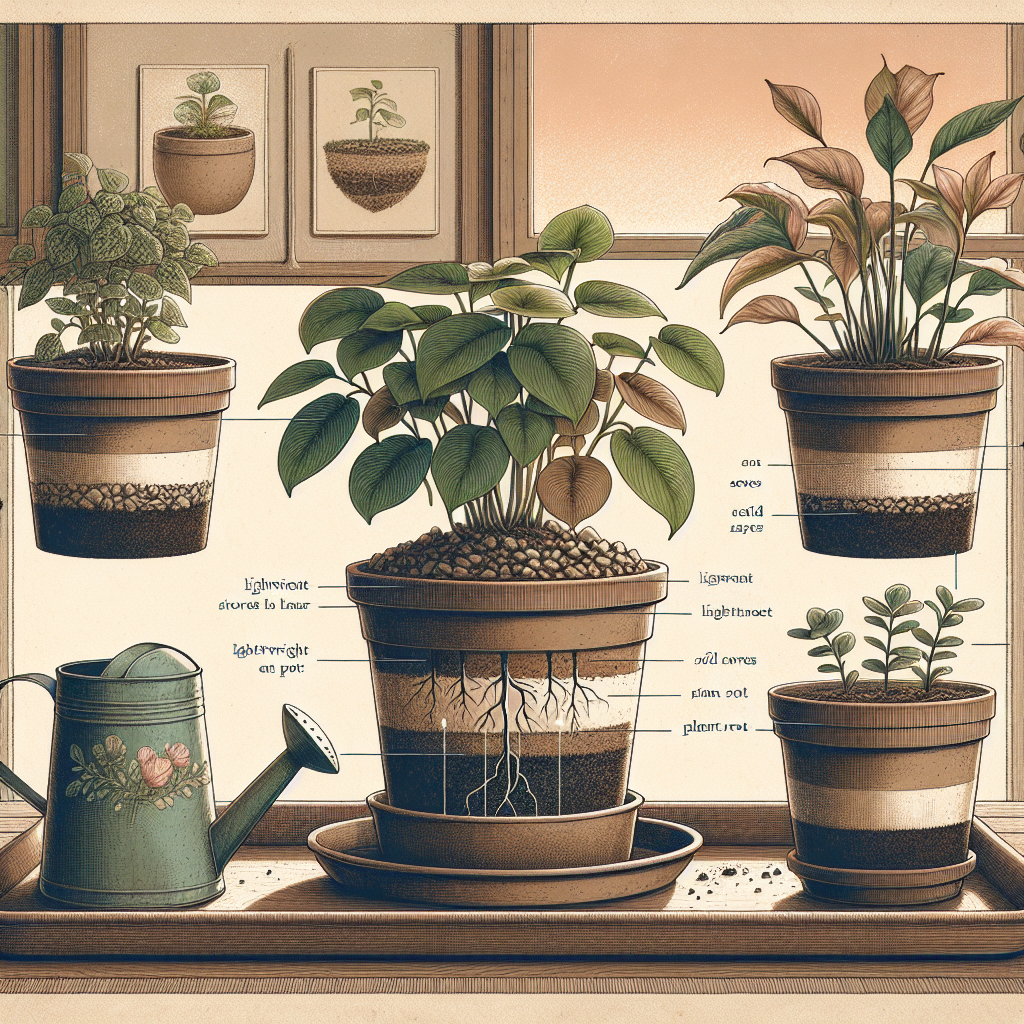Montana’s Garden Menaces: Plant Dangers
Updated May 3, 2024 at 5:58 am

Understanding Montana’s Garden Menaces
-
Pet Friendly
While some plants can beautify your garden, its important to know which can pose risks to your furry friends. Many common garden plants in Montana can be toxic to pets if ingested.
Light Requirements
The amount of sunlight your garden receives can greatly influence the type of unwanted plants that may take root. Some invasive weeds thrive in the intense sunlight of Montanas climate.
Watering
Over or under-watering your garden can also impact the proliferation of garden menaces. Standing water can promote the growth of certain moulds and fungi, detrimental to other plant life.
Humidity
Moisture levels in the air can affect plants differently. High humidity can lead to unwanted moss or mildew, while low humidity can make your garden susceptible to dry-weather pests.
Temperature
Many invasive plants and pests have a temperature range in which they are most active. Montanas varying temperatures can either deter or encourage the growth of certain garden threats.
Difficulty
Managing these unwelcome visitors ranges from easy home remedies to possibly needing the help of professional grade products or services.
Common Invasive Plants and How to Identify Them
When it comes to identifying garden menaces, knowing what youre up against is half the battle. In Montana, certain invasive plants are notorious for wreaking havoc on native ecosystems. For example, Leafy Spurge (Euphorbia esula) is easily recognizable by its bright yellow-green flowers and milky sap, while Spotted Knapweed (Centaurea stoebe) is identified by its purple, thistle-like flowers.
Controlling these pests can be a challenge, but starting with proper identification is crucial. For Leafy Spurge, there are herbicides like Tordon that can be effective if used thoughtfully. Reviews suggest that Tordon, when applied correctly, prevents the regrowth of this invasive species, saving many gardeners hassle down the road.
Find This and More on Amazon
When and How to Remove Invasive Species
Removing invasive species requires a strategic approach. For instance, the timing of your control measures can be critical. Certain plants are best removed before they set seed, such as the noxious weed, Houndstongue, known for its reddish-purple flowers and nutlet seeds. Physical removal combined with proper disposal is essential to prevent reinfestation.
Going hand in hand with manual removal is the use of weed barriers or ground covers that suppress the growth of these invaders. Products like DeWitt Weed-Barrier Fabric come highly recommended. Users report it being an effective solution against widespread growth, as it allows water and nutrients in while keeping weeds out.
Find This and More on Amazon
The Role of Pests in Garden Health
Pests pose another significant threat to garden health. Aphids and spider mites, for example, can rapidly colonize a garden, sucking the life out of plants. They are small and can be hard to spot but leave a telltale sign of plant distress and often a sticky residue known as honeydew.
In dealing with these pests, insecticidal soaps, such as Safer Brand Insect Killing Soap, are a common solution. It’s said that users find it effective against soft-bodied insects without harming beneficial insects when used as directed. The soap works on contact, so thorough coverage is crucial.
Find This and More on Amazon
Natural Remedies and Prevention Strategies
Beyond commercial products, there are numerous natural remedies and prevention strategies to consider. Companion planting, for example, is a natural and effective way to deter garden menaces. Planting marigolds among your vegetables can help repel pests like nematodes and tomato hornworms with their strong scent.
Another popular strategy is the use of beneficial insects. Ladybirds, for instance, are voracious eaters of aphids, and encouraging their presence in your garden can be a natural line of defense. It might surprise you, but purchasing live ladybirds online, such as the ORCON Ladybird Beetles, has become a common practice among gardeners. They are reviewed to effectively manage aphid populations, and they provide an eco-friendly alternative to chemical treatments.
Disease Control: Identifying and Managing Plant Illnesses
Diseases, like pests, can also spell disaster for gardens. Common signs to watch for include discoloration, wilt, and moldy coatings on plants. For instance, powdery mildew, with its characteristic white, powdery coating on leaves, thrives in dry, warm conditions commonly found in Montana.
Managing such diseases often involves both cultural practices and the use of fungicides. Neem oil, like Bonide Neem Oil Fungicide, Insecticide, & Miticide, is touted for its efficacy against a range of garden afflictions. Feedback from users suggests that it not only helps control diseases but also manages pests and mites, making it a versatile product for gardeners facing multiple issues.
Find This and More on Amazon
Recommendations for Chemical-Free Gardening
For those seeking a chemical-free approach, your strategy starts with soil health. Composting and using organic mulches can greatly improve soil vitality, which in turn, helps plants resist pests and diseases naturally. Applying compost, like Black Gold Compost, which comes highly praised for its rich nutrient content, can bolster your garden’s overall health.
Additionally, manual prevention methods such as hand-pulling weeds and regular monitoring for signs of pests and diseases can be remarkably effective. Combining physical labor with preventative measures ensures you can enjoy your Montana garden without compromising on eco-friendly practices.
Professional Assistance: When to Seek Help
Tackling garden menaces can be a daunting task and sometimes requires the expertise of professionals. If your garden is overwhelmed by invasive plants or persistent pests, seeking help from a local horticulturist or an extension service can be invaluable. They can offer tailored advice and solutions that can save you time and resources in the long run.
Local garden centers can also be a fountain of knowledge, providing insights into region-specific problems and products they carry that can help, such as regional herbicide formulations or biological controls that are suited to Montana’s unique environment.
Encouraging a Thriving Ecosystem
Ultimately, the goal is to create a balanced and healthy garden ecosystem that can withstand the common menaces in Montana. This includes fostering biodiversity, attracting pollinators, and building a robust and resistant garden through mindful practices and informed choices.
Remember, a garden is a dynamic and living space. By understanding the specific challenges it faces and how to combat them effectively, you can ensure that your little slice of nature remains a vibrant and welcoming habitat for the plants and creatures that enrich it.
Essential Tools For Managing Montana Garden Threats
When it comes to maintaining garden health, having the right tools can make all the difference. For instance, a sturdy pair of garden gloves is essential when dealing with prickly weeds or handling chemical products. Resilient and comfortable gloves like the Pine Tree Tools Bamboo Gardening Gloves are often recommended for their durability and breathability, making them ideal for long hours of garden work.
Another indispensable tool is a quality garden hoe. The Prohoe Rogue Garden Hoe is praised for its tough, sharp edge designed to cut down weeds with ease. It’s crafted from recycled agricultural disc blades, making it not only effective but also environmentally conscious—something to appreciate when advocating for healthy ecosystems.
Combatting Garden Menaces With Mulching
Mulching is an effective method to prevent the spread of invasive weeds. By layering organic material on the soil, you can suppress weed growth, retain moisture, and add nutrients. A widely used mulch for its efficacy is Scotts Nature Scapes Color Enhanced Mulch. Its color enhancements provide aesthetic appeal, and reviews highlight how the thick layer reduces the need for frequent weeding.
When applying mulch, it’s key to lay it around the base of plants and not against the stems to prevent rot and pest infestation. Natural mulches like cedar bark are not only visually pleasing but also emit scents that naturally deter pests.
Practices to Prevent Pest Invasions
Preemptive measures against pests can save a heap of trouble. Many gardeners adopt crop rotation and keep plant debris cleared to disrupt the life cycle of pests. Others suggest installing bird feeders to encourage feathered friends that feast on insects. A popular choice among bird enthusiasts is the Brome Squirrel Buster Bird Feeder, which is designed to attract birds while resisting squirrels, ensuring that your birdseed goes to the intended guests.
Keeping your garden tools clean is also a simple yet effective practice. It’s a minor detail that can prevent the spread of disease from one plant to another. Tools like the Corona Sharpening Tool are said to keep edges sharp and reduce the likelihood of transferring pathogens, benefiting overall plant health.
Impact of Climate on Montana’s Plant Dangers
Montana’s fluctuating climate can greatly influence which garden menaces thrive. For instance, extended periods of wet weather can encourage the growth of slugs and snails. Combatting these pests can be done with environmentally friendly options like diatomaceous earth, which is known to be effective and safe for use around pets and wildlife.
Similarly, drought conditions might require xeriscaping with plants that are less appealing to pests and more resistant to diseases. Choosing native plants and following sustainable landscaping practices can lead to less maintenance and fewer problems in the long run.
Engaging With Community for Shared Wisdom
Gardening is often a shared passion, and many find that engaging with the local community can lead to valuable insight. Joining a gardening club, participating in forums, or visiting community gardens are ways to connect with other gardeners facing similar challenges. Often, shared wisdom is the key to finding effective, time-tested solutions for common garden menaces.
Montana’s Extension Service is another resource, offering workshops and publications that can educate on controlling invasive species and pests sustainably. Their hands-on approach can also connect you with experts who are familiar with the unique challenges posed by the state’s climate and environment.
Choosing Resistant Varieties for Montana Gardens
When selecting plants for your Montana garden, opting for disease-resistant varieties can make for a more resilient green space. Look for plants that are bred to endure the local climate and soil conditions. Certain cultivars are recognized for their resistance to common problems like fungal diseases or infestations, and planting them can significantly reduce the need for interventions.
Nurseries and plant catalogs often list these resistant varieties, including some fantastic native plants that are well-suited to Montana’s conditions. Choosing natives not only supports local ecosystems but also means less work for you, as these plants naturally flourish in your garden’s environment.
Maintaining Soil Health to Combat Garden Threats
Healthy soil is the foundation of a healthy garden, acting as a strong defense against Montana garden menaces. Amending soil with compost and organic matter can boost its structure, water retention, and nutrient content. Many experienced Montana gardeners swear by local products like Yum Yum Mix Soil Conditioner, noting it adds a rich array of minerals that stimulate plant growth and enhance soil biology.
Soil testing kits are also widely recommended, such as the MySoil Soil Test Kit, which helps you understand your soil’s pH and nutrient levels. Adjusting these levels accordingly can make your garden less hospitable to certain weeds and more welcoming to desired plants.
Find This and More on Amazon
Integrated Pest Management for Holistic Control
Integrated Pest Management (IPM) is a holistic approach to managing garden threats, combining various methods like biological control, habitat manipulation, and the judicious use of pesticides. It aims to minimize environmental impact and promote sustainable gardening. The Montana State University Extension provides valuable resources on IPM practices suitable for local gardens.
Implementing IPM often starts with simple steps such as introducing plants that attract beneficial insects, or using floating row covers to protect crops from flying pests. Monitoring and responding to pest pressures only when they reach a certain threshold ensures you don’t intervene unnecessarily, maintaining a natural balance in your garden’s ecosystem.
Educating Yourself on Local Flora and Fauna
Understanding the local flora and fauna can be a monumental asset in combatting Montana’s garden threats. By knowing which plant species are native and which are potential threats, you can plan your garden accordingly. Books like “Montana’s Noxious Weeds” by Robert L. Zimdahl offer a comprehensive guide to identifying and managing unwanted plants in the state.
Additionally, engaging with local conservation groups or visiting botanical gardens can provide hands-on learning experiences. These organizations often lead the fight against invasive species and can offer practical advice and assistance for your garden management efforts.
Creating a Long-Term Garden Management Plan
Sustainable garden management in Montana requires a long-term approach. Creating a plan that includes regular maintenance routines, such as mulching, pruning, and scouting for pests, can prevent many problems before they start. Setting aside time each week for garden inspection can save you from larger issues down the road.
Keep detailed records of what works and what doesn’t in your garden. Many gardeners find success with gardening apps or journals that help them track plants’ progress, pest invasions, and effective treatment methods.
Protecting Your Garden’s Biodiversity
Maintaining a diverse assortment of plants in your garden isn’t just visually pleasing—it also contributes to a more robust defense against pests and diseases. When you encourage biodiversity, you invite a variety of insects and wildlife that act as natural pest controllers. Plants like the Montana native Bitterroot or the Blanket Flower add beauty and resilience to your green space.
Implementing diversity can be as simple as mixing up plant varieties in your borders, or as intricate as creating habitat features like ponds or insect hotels that support a range of wildlife. The end goal is a balanced ecosystem where potential threats are kept in check by natural means.
Continuing Education Through Workshops and Seminars
Education is a powerful tool for any gardener, and in Montana, there are ample opportunities to learn more about managing garden menaces. Workshops, seminars, and webinars offered by local colleges, gardening societies, and extension services can provide you with the latest information on sustainable gardening practices and pest management strategies.
Don’t underestimate the value of these educational resources. They can connect you with expert knowledge, new techniques, and a community of fellow gardeners who share a commitment to fostering healthy and beautiful gardens in the face of Montana’s challenges.
Frequently Asked Questions Answered by Local Experts
Gardening comes with many questions, especially when dealing with troublesome plants and pests. Luckily, Montana’s local agriculture extensions and gardening clubs often provide Q&A services for gardeners. These platforms allow you to get quick and reliable answers to pressing questions about garden menaces from experienced professionals who understand the unique Montana environment.
For specific concerns, these Q&A sessions can be incredibly useful. Whether it’s identifying a peculiar weed or figuring out how to deal with a sudden pest infestation, local expert advice can guide you towards the best solution for your garden.
Embracing the Challenge for a Rewarding Garden Experience
Gardening in Montana, with its myriad of plant dangers, can seem daunting, yet it’s part of the rewarding experience of cultivating your little oasis. Overcoming these challenges not only leads to a thriving garden but also contributes to your growth as an eco-conscious gardener. It’s about perseverance, adaptability, and the willingness to learn and apply new strategies.
Whether you’re battling invasive weeds, deterring pests, or nurturing delicate native flowers, each step towards a healthy, vibrant garden is a victory against the garden menaces of Montana. Embrace the journey, and you’ll find that the results are well worth the effort.
Shop more on Amazon

